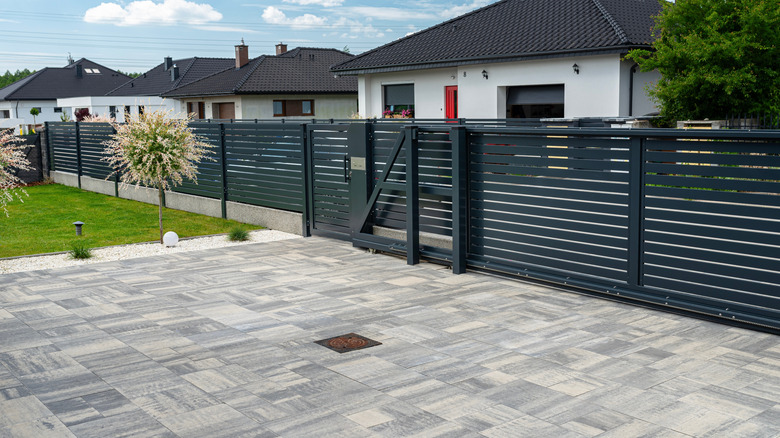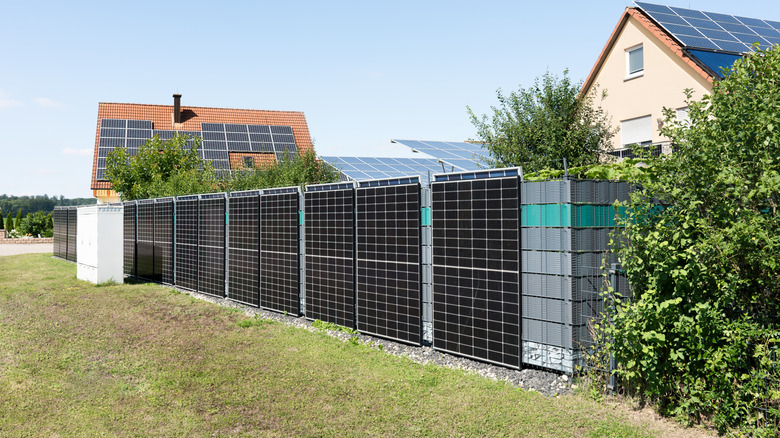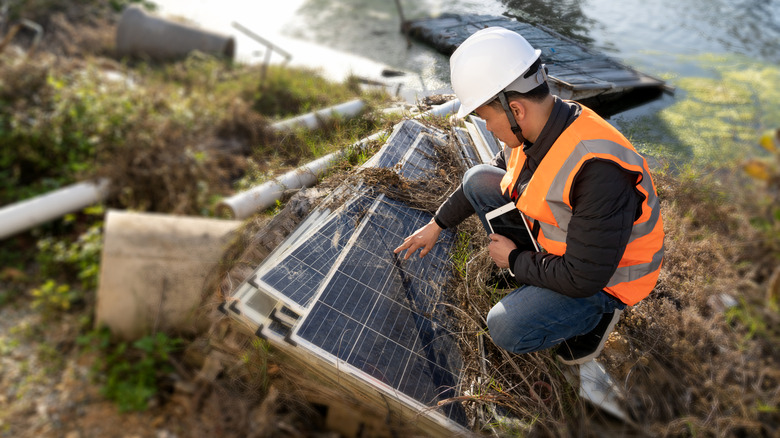The Fence Solution That Could Provide Far More Power For Your Home
Whether you're a penny-pinching tiny home dweller or the owner of a sprawling mansion, you want value when you sink money into your property. Among the eco-friendly renovations that give you a top return on investment, solar panels are a major player. If you can get twice as much use out of your panels with a concept that also yields more energy production, it's worth paying attention to. Several innovative companies around the world are making what might be the perfect fence: enclosures consisting of vertically mounted solar panels with photovoltaic cells on one or both sides.
Solar fences give you privacy, security, and electricity. The clincher is how the two-sided panel design soaks in the rays all day long, resulting in up to 10% more energy production than rooftop solar panels. Roof-mounted panels absorb most of the energy in the middle of the day, but two-sided fence panels maximize sunlight in both the morning and the evening. And with winter sunlight in most of the world coming in at a lower angle, solar fences can generate more electricity in the winter than they do in the summer months. Even if you don't need to enclose a part of your property, these panels can stand in as a multi-purpose privacy screen or fit your needs if your home's roof can't accommodate solar panels. However, are solar fences too good to be true? As with most things, there are a few downsides to consider before opening up your wallet.
Winning features
The price of solar fences might give you a bit of a shock. At first glance, over $3,000 for a 32-foot fence makes this some of the most expensive types of fence materials you can find. However, with their multiple purposes, their ability to capture energy at more times of day than roof-mounted solar panels, and the savings on energy and possible tax rebates, this may be a better deal than it first appears. In fact, the price of installing solar fencing is comparable to putting up separate solar panels and a conventional fence of the same size. Tack on the fact that this privacy fence needs no paint or stain to maintain, and the eyebrow-raising price tag starts to look like a good deal. Additionally, you could make some of your money back when you come to sell since adding solar panels to your home can increase its value.
Also, if you live in a snowy area, the vertical faces won't hold on to snow, which could block valuable sunlight. Some companies offer additional upgrades like climb-over protection and bar mesh mats that can keep pets in and pests out. There's little in life that requires no upkeep at all, and solar fences aren't entirely maintenance-free either. Panels need to be cleaned from time to time for optimal performance, but being able to do that without climbing atop your roof will be a plus for many homeowners.
Limitations
All in all, there seem to be more pros than cons to solar fencing. Yet, disadvantages do exist along with a good number of unknowns involved with this unconventional type of enclosure. Not every yard will be suitable for a solar fence. Heavily treed lots are a given, but there's also shade cast by houses and other nearby structures that may block out too much sun to make this technology worth the investment. It may be worth looking into a fence with only one or a few sections of solar paneling placed where they'll get the most sun.
Without many customer reviews available, it's hard to know how solar fences hold up to residential challenges. Their design might not be ideal for areas that get consistent high winds. Also, will the glass panels stand up to the inevitable bumps and scratches inflicted by excited pets, active children, and wind-borne debris? Plus, neighborhoods with strict HOAs may not allow this type of fencing at all. It may be wise to press pause on plans to install a solar fence until we know more about its performance and durability in the long term.


